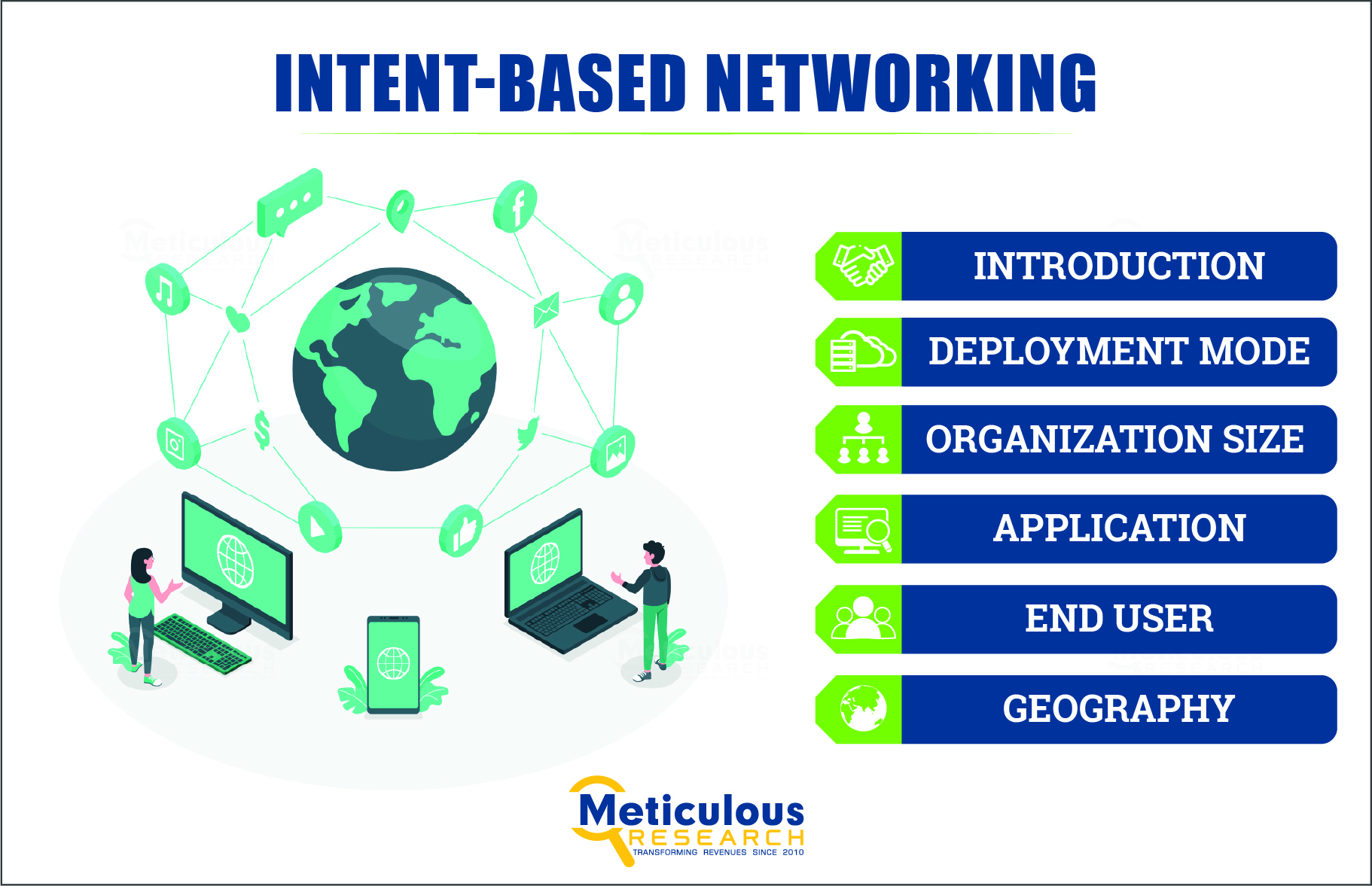
The Intent-Based Networking Market is projected to grow to $8.9 billion by 2031, with a compound annual growth rate (CAGR) of 23.9% from 2024 to 2031.
Zero Trust Networking: Enhancing Security Through Intent-Based Networking
Zero Trust Networking (ZTN) is revolutionizing the way organizations approach IT security, particularly in light of the growing number of cyber threats and the complexities of modern digital environments. This security model emphasizes strict identity verification for every user and device attempting to access resources on a private network, effectively dismantling the concept of implicit trust that has long been associated with traditional network architectures. By adopting ZTN, organizations can bolster their security posture, minimize potential attack surfaces, and safeguard sensitive data through rigorous authentication, access controls, and continuous monitoring.
The Core Principles of Zero Trust Networking
At its core, Zero Trust Networking operates on the premise that no user or device should be trusted by default, regardless of whether they are inside or outside the organization’s network perimeter. This is achieved through several key principles:
1. Network Segmentation: By breaking networks into smaller, more manageable segments, organizations can limit the potential damage from a security breach. This segmentation ensures that even if an attacker gains access to one part of the network, they cannot easily move laterally to other segments.
2. Layer 7 Threat Prevention: ZTN employs application-layer controls that analyze traffic for malicious behavior. This level of scrutiny allows organizations to identify and block threats before they can exploit vulnerabilities in applications or data.
3. Preventing Lateral Movement: One of the primary goals of ZTN is to prevent attackers from moving within the network once they gain access. By enforcing strict access controls and monitoring user behavior, organizations can contain potential breaches and minimize the impact of an attack.
4. Granular User Access Control: ZTN emphasizes the importance of fine-grained access controls based on user identity, device posture, and contextual information. This approach ensures that users only have access to the resources necessary for their roles, further reducing the risk of unauthorized access.
Download Sample Report Here: https://www.meticulousresearch.com/download-sample-report/cp_id=5593
The Role of Intent-Based Networking in Zero Trust Security
Intent-Based Networking (IBN) complements the principles of Zero Trust Networking by providing a framework for implementing and managing security policies effectively. IBN utilizes automation and artificial intelligence to understand the intended outcomes of network operations, allowing organizations to align their security controls with their business objectives.
By integrating Zero Trust principles into IBN solutions, organizations can achieve robust security across their networks in the following ways:
1. Fine-Grained Access Policies: IBN enables organizations to enforce precise access policies based on real-time data about users and devices. This capability is crucial for ensuring that only authorized users can access sensitive information and applications.
2. Real-Time Monitoring and Threat Detection: With IBN, organizations can continuously monitor user and device behavior, quickly identifying and responding to security threats. This proactive approach to security helps organizations stay one step ahead of potential attackers.
3. Streamlined Policy Implementation: The automation capabilities inherent in IBN allow for the rapid deployment of Zero Trust policies. By automating access controls, authentication processes, and network segmentation, organizations can significantly reduce the risk of human error and ensure consistent security measures across their networks.
4. Dynamic and Adaptive Access Controls: IBN facilitates the creation of dynamic access controls that adapt based on various factors, including user identity, device health, and environmental context. This flexibility is essential in today’s rapidly evolving threat landscape, where security needs can change in an instant.
Check complete table of contents with list of tables and figures: https://www.meticulousresearch.com/product/intent-based-networking-market-5593
The Evolving Need for Zero Trust Networking
Over the past decade, the shift toward Zero Trust Networking has become imperative for organizations seeking to protect themselves against evolving cyber threats. Traditional network architectures, which often rely on perimeter defenses and implicit trust, have proven inadequate in the face of sophisticated attacks. As organizations increasingly embrace cloud services and adopt Bring Your Own Device (BYOD) policies, the need for robust security frameworks has never been more urgent.
ZTN addresses these challenges by providing a security architecture that denies access by default. This “never trust, always verify” approach ensures that even trusted users must prove their identity and authorization before accessing network resources. By integrating Zero Trust principles into intent-based networking solutions, organizations can enhance their security posture, safeguard their sensitive data, and mitigate risks associated with unauthorized access.
Benefits of Intent-Based Networking in Zero Trust Environments
The integration of intent-based networking within Zero Trust environments yields numerous benefits for organizations, including:
1. Lateral Movement Prevention: ZTN and IBN work together to prevent lateral movement of threats within the network. By segmenting the network and enforcing strict access controls, organizations can effectively contain potential security breaches.
2. Regulatory Compliance: With increasing scrutiny from regulatory bodies, organizations must adhere to compliance requirements regarding data protection and security. IBN provides a framework for continuous monitoring, access auditing, and risk mitigation, helping organizations meet these regulatory demands.
3. Enhanced Security Posture: The combination of Zero Trust principles and intent-based networking solutions allows organizations to enforce fine-grained access policies, monitor user and device behavior, and respond to security threats in real-time, thus enhancing their overall security posture.
4. Reduced Human Error: By automating the implementation of Zero Trust policies, organizations can minimize the risks associated with human error. Automation improves consistency in security practices and allows teams to focus on more strategic initiatives.
Conclusion
As organizations navigate an increasingly complex digital landscape, the importance of Zero Trust Networking cannot be overstated. By requiring strict identity verification and implementing rigorous access controls, ZTN offers a robust framework for protecting sensitive data and minimizing the risk of unauthorized access. The integration of intent-based networking further enhances these security measures, enabling organizations to automate policy enforcement, monitor user behavior in real time, and adapt to emerging threats.
The transition to Zero Trust Networking is not merely a trend but a necessary evolution in IT security. Organizations that embrace this model will be better equipped to defend against the sophisticated cyber threats of today and tomorrow, ensuring the integrity and confidentiality of their critical resources. As the cyber threat landscape continues to evolve, the combination of Zero Trust Networking and intent-based networking will undoubtedly play a pivotal role in shaping the future of secure network architectures.
Quick Buy: https://www.meticulousresearch.com/Checkout/53537662
Intent-based Networking Market Research Summary
| Particulars | Details |
| Number of Pages | 263 |
| Format | |
| Forecast Period | 2024–2031 |
| Base Year | 2023 |
| CAGR | 23.9% |
| Market Size | $8.9 billion by 2031 |
| Segments Covered | By Offering
By Deployment Mode
By Organization Size
By Application
By End User
|
| Countries Covered | Europe (Germany, U.K., France, Italy, Spain, Netherlands, and Rest of Europe), Asia-Pacific (China, Japan, India, South Korea, Thailand, Indonesia, Australia & New Zealand, and Rest of Asia-Pacific), North America (U.S. and Canada), Latin America (Brazil, Mexico, and Rest of Latin America), and the Middle East & Africa (UAE, Israel, and Rest of Middle East & Africa) |
| Key Companies Profiles | Arista Networks, Inc. (U.S), Cisco Systems, Inc. (U.S.), Juniper Networks, Inc (U.S.), Fortinet, Inc. (U.S.), VMware, Inc. (U.S.), Hewlett Packard Enterprise Company (U.S.), Nokia Corporation (Finland), Huawei Technologies Co., Ltd. (China), IBM Corporation (U.S.), Anuta Networks International LLC (U.S.), NetBrain Technologies, Inc. (U.S.), Forward Networks, Inc. (U.S.), Gluware, Inc. (U.S.), NetYCE BV (Netherlands), AppViewX (U.S.), and Itential (U.S.). |
About Meticulous Research®
Meticulous Research® is a leading provider of comprehensive market intelligence, offering actionable insights and analysis across various industries. Our reports empower businesses to make informed decisions, drive growth, and remain competitive in a rapidly evolving marketplace.
Contact Us:
Meticulous Market Research Pvt. Ltd.
1267 Willis St, Ste 200 Redding,
California, 96001, U.S.
USA: +1-646-781-8004
Europe : +44-203-868-8738
APAC: +91 744-7780008
Email- sales@meticulousresearch.com
Visit Our Website: https://www.meticulousresearch.com/
Connect with us on LinkedIn- https://www.linkedin.com/company/meticulous-research







